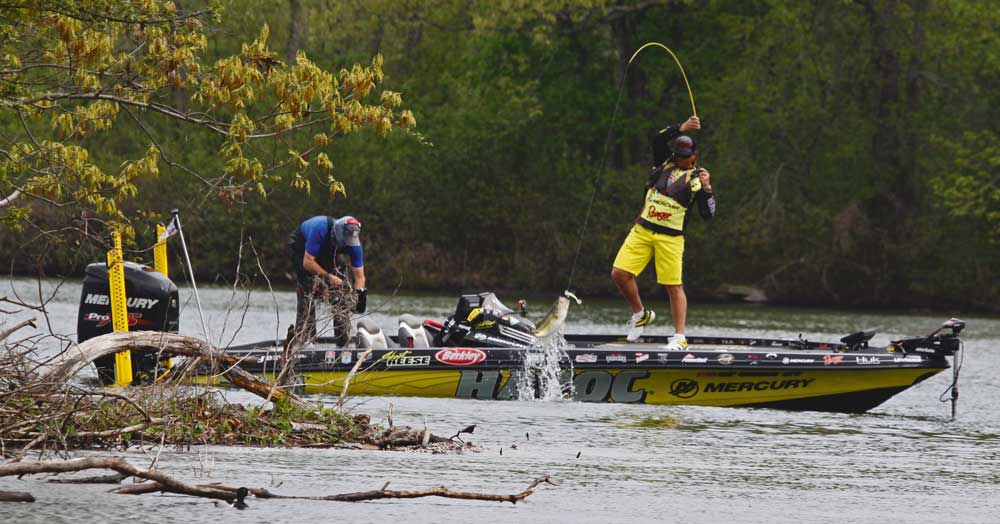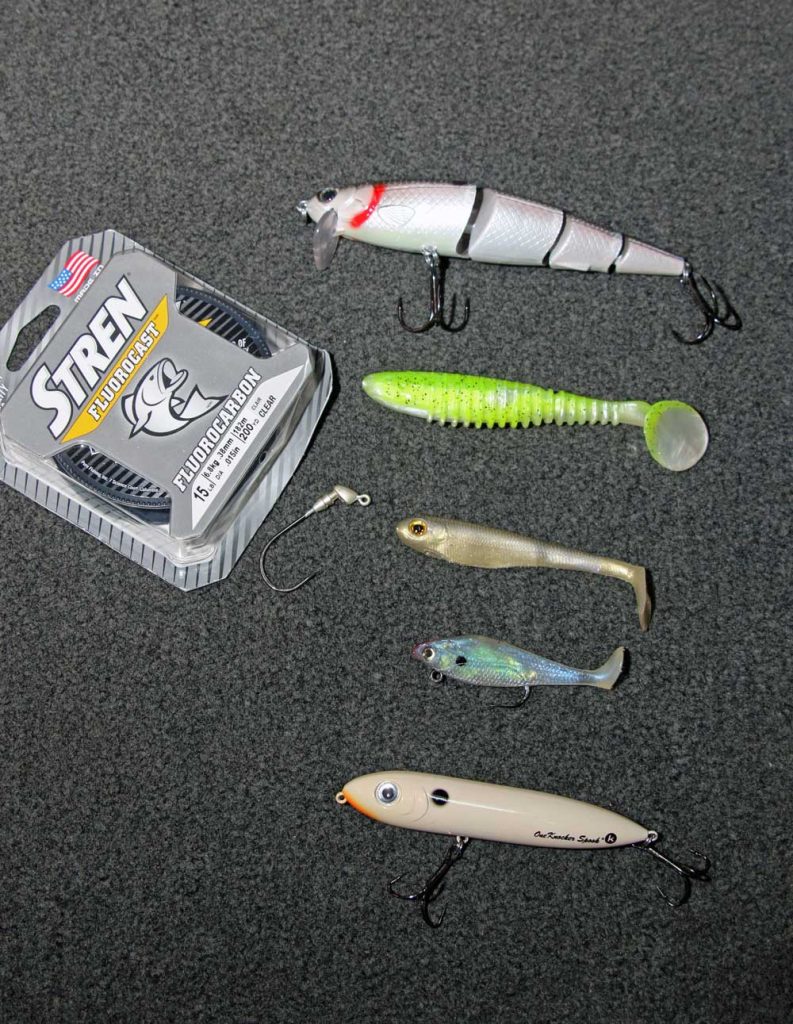Swimbaits for Bass – How To Choose Them
Spring is in the air, at least for some parts of the state. Warm days will have bass inching their way from winter hideouts toward their spawning grounds. The big females will usually be the first ones to move up. While many anglers will opt for the standard spring arsenal of lures, swimbaits for bass can be a productive alternative.
Swimbaits can catch fish year-round, especially larger bass. The natural looking, almost lifelike lures have won their share of major bass tournaments across the country. While swimbaits can be a top choice any season, springtime is a favorite for swimbait anglers.
Swimbait lures in the 7- to 12-inch and larger range migrated east from California anglers. Bass anglers in Texas have used these simple lures in lakes such as Falcon, Fork, and Amistad. Soon the secret was out and swimbaits have found a home in many angler’s tackle bags.
In December of last year, Dr. Tom Martens of Austin, Texas punched his ticket to the Bassmaster Classic by winning the Toyota Bonus Bucks Bassmaster Team Championship on Lake Guntersville. The primary lure responsible for his win was a soft-plastic swimbait.
A side note, Martens is not related to Elite pro Aaron Martens of Leeds, AL.

The Best Swimbaits For Bass
The term swimbait can cover a variety of different styles and type in that segment of lures. Some baits are made from hard plastic. Other models of swimbaits are jointed with sections of rubberized plastic.
Certain types and special styles of swimbaits for bass can sell for $100 or more. However, the types of swimbaits we are focusing on here are made of soft-plastic. And they are much more affordable in the $6 to $15 range in multiple lure packs.
Many bass anglers are not accustomed to fishing with swimbaits. Their lures are a little different than the standard array. Also, the swimbait bass lures require a little more effort to learn how to fish them effectively.
However, swimbaits can produce heavy stringers of bass when fished properly. Most soft type swimbaits for bass resemble a long cigar-shaped baitfish like shad and blueback herring. Also, some manufacturers make swimbaits that resemble a bream or other sunfish. These style lures are a top choice in smaller lakes and ponds where bream are the primary forage.
“The BassTrix swimbait is hand-poured back in California,” comments B.A.S.S. Elite pro Byron Velvick, who resides in Boulder City, Nev. “The bait has paddle style tail, perfect for swimming it slowly.”
In April 2015, it was Velvick who turned pro angler Skeet Reese of Auburn, California on to the BassTrix bait at an Elite event on Lake Guntersville. Reese went on to win that tournament by fishing the seven-inch model. Velvick finished in second place.
“In most cases, color is not as important as the action.”
Bass anglers on lakes around the Cotton State prefer a soft-plastic style swimbait. The baits are shaped like a shad or other baitfish. Some baits have a paddle tail that induces a natural swimming action and vibration on a retrieve. Some baits are fashioned to appear like a baitfish. These lures, too, have a built-in tail action to give bass a realistic appearance.
“On some lakes, like Guntersville, color is not as important as matching the size of the swimbait to the natural forage,” Reese reports. “On my win at Guntersville, the seven-inch size was key to getting strikes.”
Reese used a white-colored swimbait. But he would also switch some to ayu-colored bait. Martens primarily used the ayu color to catch his winning load of bass.
B.A.S.S. pro angler Steve Kennedy of Auburn, AL has won two Elite Series events fishing swimbaits. In 2011, he took home the trophy from West Point Lake by primarily using two different styles of swimbaits. Kennedy alternated between a soft-plastic hollow body and a segmented jointed bait.
“The key is to determine which type of action from the swimbait the bass prefer,” Kennedy says. “In most cases, color is not as important as the action.”
Kennedy says swimbaits for bass can have different types of vibration. Even a small change in lure size or material type and form will have a different action.

Swimbait Techniques
The soft-plastic style swimbaits can be rigged in several different methods. The most common type used is a weighted hook designed for swimbaits. Weights in the 3/8- to 3/4-ounce size are favored by most anglers. The bait is rigged with the hook concealed in the body of the bait.
“I like the 7/0 size Trokar magnum swimbait hook for the seven-inch Basstrix bait,” Reese says. “This is a heavy hook and requires strong line.”
Reese says if he’s fishing the swimbait around cover, he prefers a heavy line. At the Guntersville Elite event last April he spooled 65-pound-test braided line. He would then tie a 25-pound-test fluorocarbon leader to the braid and to the hook.
Some anglers prefer a weighted head style hook for their swimbaits. These are rigged in the bait with the hook exposed. This rig is great for open water fishing where cover is minimum. In clear water, bass will be less suspicious and the bait will have a natural appeal when using fluorocarbon line.
“You want to cover as much water as possible on each cast,” Reese explains. “Long casts are important in getting the bait in front of the fish without spooking them.”
Reese says make long casts across points or flats near deeper water. Anglers should allow the bait to reach the depth where the bass are holding. A slow, steady retrieve is key. In cold water conditions, bass will not want to chase after the bait. The retrieve should be just fast enough to make the tail swim.
During the pre-spawn, swimbaits for bass are effective around bridges and creek channel breaks. Baitfish will suspend in and around creek channels. Also, channel intersections with another creek or large ditch can also hold fish. This time of year bass are schooling in these areas near or under the baitfish.
Bass will position themselves at various locations around the bridge. Current, water temperature, wind, and cloud cover can have an effect where the bass place themselves. Anglers will need to probe different locales with their swimbait to uncover prime spots.
Also, bass can relocate at various positions around the bridge structure with changing conditions. If the action stops or slows, try a different approach or casting angle to or away from the bridge.
“In the early spring during the pre-spawn, small pockets and coves are good areas to try a swimbait,” Kennedy advises. “The water will warm quicker in these areas and the bass will be a little more active.”
Kennedy prefers a shad-colored swimbait during the spring months. The hollow-body style baits like the Basstrix work great. They can be cast to visible covers such as stumps, rocks, and logs. He says to start out with a slow retrieve with just enough forward motions to swim the tail of the bait.
After a few casts, anglers should try a faster retrieve speed or vary the retrieve with a stop-and-go technique. If the strikes are few and you know bass are in the area, Kennedy suggests using a floating swimbait to simulate a dying baitfish.
“Swimbaits perform best in clear to slightly stained water.”
With the swimbaits for bass rigged weedless, any type of cover can be productive. Stumps, rocks, logs, and blowndown tops are prime areas to catch bass with a swimbait. Anglers may want to opt for a lighter weight bait to cast to visible cover.
“Laydown logs are spots where bass will hold,” Reese says. “The bass may be a little more aggressive around the cover, but you still want a slow retrieve on the bait.”
Reese says he will stop his bait several feet from the boat. In some cases, a bass may be following the bait and will strike when the bait suddenly stops.
With heavy baits in action, strong, durable gear will be required to handle the fishing. Medium-heavy to heavy action bait-casting rods will take some of the work out of fishing swimbaits. Most anglers prefer rods around seven feet and longer to make long, maximum casting distance and a good hook-set. Bait-casting reels coupled to the rods with a 6.3:1 or higher gear ratio will relieve some of the stress of long casts and slow retrieves.
Swimbaits for bass perform best in clear to slightly stained water. In clear water, bass are relying on seeing the bait before striking. The natural appearance and action of the swimbait will attract a hungry bass. For a great day outdoors, give swimbaits a try this spring.




